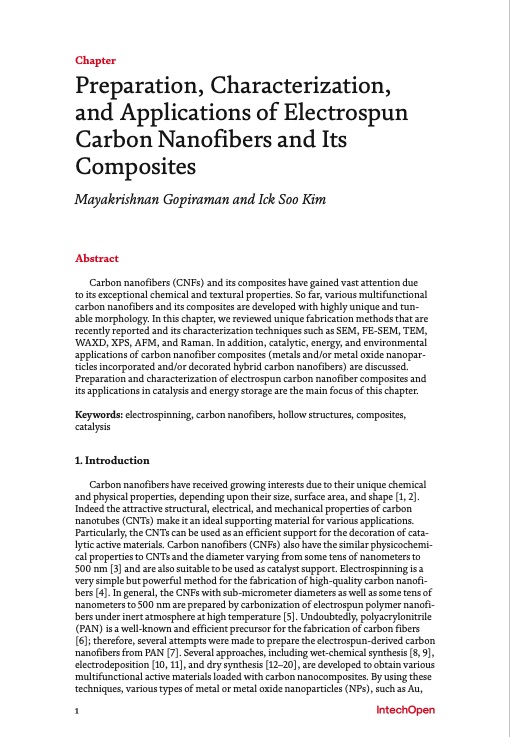
PDF Publication Title:
Text from PDF Page: 001
Chapter Preparation, Characterization, and Applications of Electrospun Carbon Nanofibers and Its Composites Mayakrishnan Gopiraman and Ick Soo Kim Abstract Carbon nanofibers (CNFs) and its composites have gained vast attention due to its exceptional chemical and textural properties. So far, various multifunctional carbon nanofibers and its composites are developed with highly unique and tun- able morphology. In this chapter, we reviewed unique fabrication methods that are recently reported and its characterization techniques such as SEM, FE-SEM, TEM, WAXD, XPS, AFM, and Raman. In addition, catalytic, energy, and environmental applications of carbon nanofiber composites (metals and/or metal oxide nanopar- ticles incorporated and/or decorated hybrid carbon nanofibers) are discussed. Preparation and characterization of electrospun carbon nanofiber composites and its applications in catalysis and energy storage are the main focus of this chapter. Keywords: electrospinning, carbon nanofibers, hollow structures, composites, catalysis 1. Introduction Carbon nanofibers have received growing interests due to their unique chemical and physical properties, depending upon their size, surface area, and shape [1, 2]. Indeed the attractive structural, electrical, and mechanical properties of carbon nanotubes (CNTs) make it an ideal supporting material for various applications. Particularly, the CNTs can be used as an efficient support for the decoration of cata- lytic active materials. Carbon nanofibers (CNFs) also have the similar physicochemi- cal properties to CNTs and the diameter varying from some tens of nanometers to 500 nm [3] and are also suitable to be used as catalyst support. Electrospinning is a very simple but powerful method for the fabrication of high-quality carbon nanofi- bers [4]. In general, the CNFs with sub-micrometer diameters as well as some tens of nanometers to 500 nm are prepared by carbonization of electrospun polymer nanofi- bers under inert atmosphere at high temperature [5]. Undoubtedly, polyacrylonitrile (PAN) is a well-known and efficient precursor for the fabrication of carbon fibers [6]; therefore, several attempts were made to prepare the electrospun-derived carbon nanofibers from PAN [7]. Several approaches, including wet-chemical synthesis [8, 9], electrodeposition [10, 11], and dry synthesis [12–20], are developed to obtain various multifunctional active materials loaded with carbon nanocomposites. By using these techniques, various types of metal or metal oxide nanoparticles (NPs), such as Au, 1PDF Image | Preparation, Characterization, and Applications of Electrospun Carbon Nanofibers

PDF Search Title:
Preparation, Characterization, and Applications of Electrospun Carbon NanofibersOriginal File Name Searched:
68337.pdfDIY PDF Search: Google It | Yahoo | Bing
Sulfur Deposition on Carbon Nanofibers using Supercritical CO2 Sulfur Deposition on Carbon Nanofibers using Supercritical CO2. Gamma sulfur also known as mother of pearl sulfur and nacreous sulfur... More Info
CO2 Organic Rankine Cycle Experimenter Platform The supercritical CO2 phase change system is both a heat pump and organic rankine cycle which can be used for those purposes and as a supercritical extractor for advanced subcritical and supercritical extraction technology. Uses include producing nanoparticles, precious metal CO2 extraction, lithium battery recycling, and other applications... More Info
| CONTACT TEL: 608-238-6001 Email: greg@infinityturbine.com | RSS | AMP |